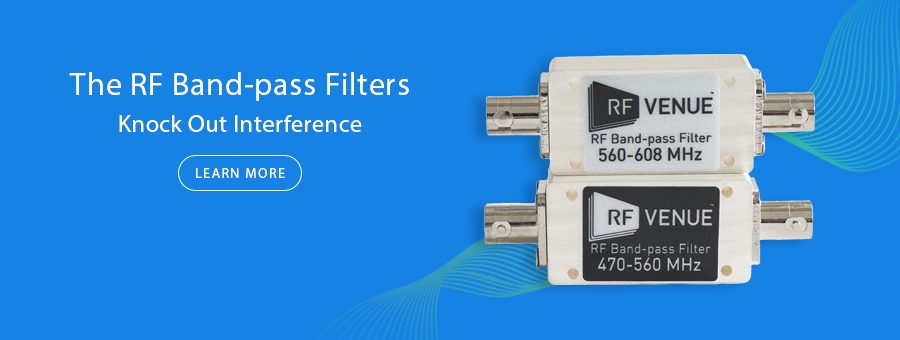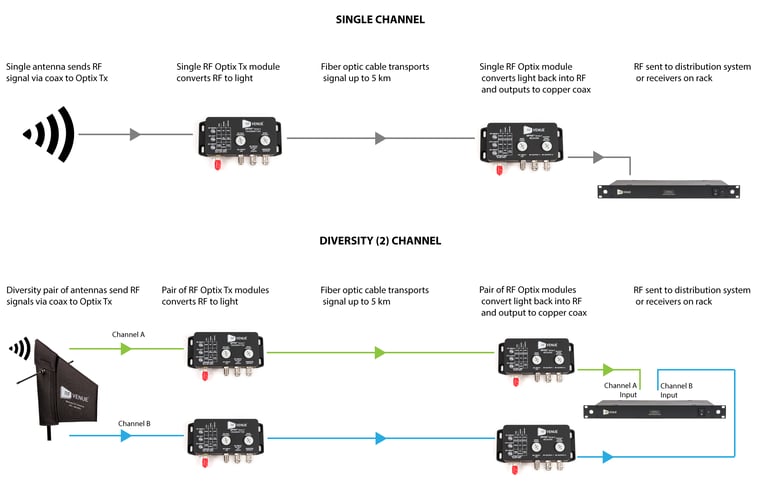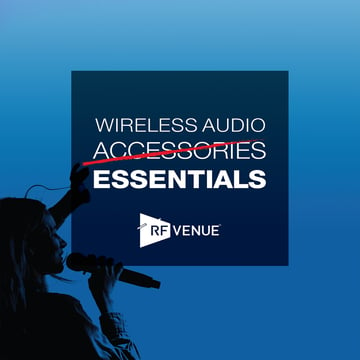- Products
- All Products
- RF PA Extension Kit
- Wireless Microphone Upgrade Packs
- In-Ear Monitor Upgrade Packs
- Wireless Microphone Antennas
- Wireless In-Ear Monitor Antennas
- Antenna Distribution for Microphones
- Antenna Combiners for In-Ear Monitors
- Multi-Zone Antenna Combiners
- Spectrum Tools
- Accessories, Cables and Parts
- Solutions by Venue
- Resources & Training
- Performance Tools
- About Us

I am often asked whether it is better to position your transmitter close to your receiver and suffer the signal loss through the coax or is it better to transmit across the audience to an antenna back at FOH? After all doesn’t my system have a range of 300’? We have visited this issue in past blog posts but I’d like to focus on it a bit differently this time.
The loss of RF power through the air, called Free Space Path Loss, is an inverse-square phenomenon. This is the same for speaker power through the air which is more intuitive to grasp since we really can’t sense RF power. The loss through coax simply doubles with each doubling of distance. So with every doubling of distance through the air we we suffer a 4x loss of signal while with coax we lose 2x every time we double distance. After a couple of doublings this becomes a huge difference.
We can better understand the path loss of a given RF link using a calculator like this one.
Plugging in some data to calculator we see that the free space path loss at 100 feet at a frequency of 550 MHz (and given a TX and RX gain of 1) is 53.93 dB. The loss through common RG58 coax is about 12dB for 100 feet. If we used a better grade of coax we could about cut that number in half.
And if we considered a more extreme case, at 300 feet through the air, the loss is almost 65 dB!
Now to counter this it might be a simple matter of selecting an antenna with a fair amount of gain, such as our CP Beam, and adding the appropriate line amp to recover the lost signal. But using a line amp or a high gain antenna also raises the noise floor.These days with the RF noise floor rising from digital TV stations, LED walls, DMX controllers and new services like the 600MHz T-Mobile service and the soon to hit the air Microsoft Whitespace project it is more important than even to maintain the best possible signal-to-noise ratio and not just worry about raw signal power.
Running distances over 150-200’ consider RF over fiber with Optix as it almost completely eliminates the coax loss and the need for line amps and the resulting rise in noise floor. It is usually far easier to run a couple hundred feet of single mode fiber than the larger coax such as RG8 and you won’t need a forklift to carry it. As we've written before, there is clearly a diminishing return to long coax runs!
So barring special circumstances, you will be far better off placing your antennas closer to the transmitters and using larger, low loss coax or RF over fiber as it will almost always result in lower total loss and therefore better signal-to-noise. However, don't go right on top of it! You do need to maintain a minimum distance from transmitter to receiver of 10 feet to avoid overloading the front end of your receivers.
Don Boomer
Don Boomer is Senior applications engineer at RF Venue. He has worked in R&D in the past for Peavey, Sabine and Line 6 and his rock band from his high school days has a song in the Rock n Roll Hall of Fame
More from the blog
Subscribe to email updates
Stay up-to-date on what's happening at this blog and get additional content about the benefits of subscribing.




.jpg?length=360&name=I%20didn't%20know%20that%20BLOG%20(1).jpg)
